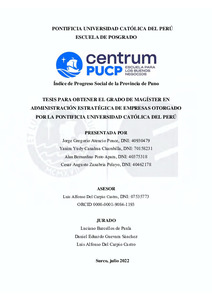| dc.contributor.advisor | Del Carpio Castro, Luis Alfonso | |
| dc.contributor.author | Atencio Ponce, Jorge Gregorio | |
| dc.contributor.author | Canahua Chambilla, Yanira Yudy | |
| dc.contributor.author | Pinto Apaza, Alan Bernardino | |
| dc.contributor.author | Zanabria Pelayo, Cesar Augusto | |
| dc.date.accessioned | 2022-11-14T17:05:57Z | |
| dc.date.available | 2022-11-14T17:05:57Z | |
| dc.date.created | 2022 | |
| dc.date.issued | 2022-11-14 | |
| dc.identifier.uri | http://hdl.handle.net/20.500.12404/23778 | |
| dc.description.abstract | El Índice de Progreso Social proporciona una medida holística, objetiva y transparente
basada en los resultados del bienestar de una provincia, compuesto de tres dimensiones
interrelacionadas: necesidades humanas básicas, fundamentos de bienestar y oportunidades;
los cuales permiten describir eficientemente la realidad social. En este sentido, el propósito
del estudio es calcular el Índice de Progreso Social de la Provincia de Puno 2019 y sus
distritos. De acuerdo al proceso metodológico los 15 distritos fueron agruparos en tres zonas,
consiguiendo como muestra 439 hogares zonificados; por medio de la validación del modelo
se filtraron 41 indicadores que conformaron la estructura del IPS provincial.
Los resultados indican que el nivel de progreso social de la Provincia de Puno fue de
nivel “Bajo” con 49.95 puntos; y en la misma categoría se encuentran sus tres dimensiones:
Necesidades Humanas Básicas con 53.77 puntos, Fundamentos de Bienestar con 47.66
puntos y Oportunidades con 48.42 puntos. El análisis de las zonas, muestra un mejor
escenario para la zona 2 la cual obtiene 62.72 puntos en un nivel de progreso “Medio Bajo”,
seguida por la zona 3 con 57.08 puntos en igual escala, y finalmente la zona 1 con 40.45
puntos en un nivel “Muy bajo”.
El análisis hecho a nivel de componentes indica que la Provincia de Puno presenta
debilidades en las tres dimensiones del IPS en: sostenibilidad ambiental, acceso a la
educación superior, condiciones de la vivienda, acceso a los servicios de agua, saneamiento,
electricidad e internet, derecho a la propiedad, planificación familiar y el acceso a bienes de
uso público. En este sentido, los resultados obtenidos permitirán evaluar el alcance de las
políticas públicas en la Provincia de Puno, y servirán como fuente de información a futuros
estudios que analicen de forma parcial o total los 41 indicadores que estructuraron el modelo
de bienestar social de la provincia para el 2019. | es_ES |
| dc.description.abstract | The Social Progress Index provides a holistic, objective and transparent measure
based on the results of the well-being of a province, composed of three interrelated
dimensions: basic human needs, foundations of well-being and opportunities; which allow
anefficient description of social reality. For this reason, the purpose of the study is to
calculatethe Social Progress Index of the Province of Puno 2019 and its districts. According
to the methodological process, the 15 districts were group into three zones, obtaining a
sample of 439 zoned households; Through the validation of the model, 41 indicators were
filtered that made up the structure of the provincial IPS.
The results indicate that the level of social progress in the Province of Puno was
"Low" with 49.95 points; and in the same category are its three dimensions: Basic Human
Needs with 53.77 points, Foundations of Well-being with 47.66 points and Opportunities
with 48.42 points. The analysis of the zones shows a better scenario for zone 2 which obtains
62.72 points in a "Medium Low" level of progress, followed by zone 3 with 57.08 points on
the same scale, and finally zone 1 with 40.45 points in a "Very Low" level.
The analysis made at the component level indicates that the Province of Puno presents
weaknesses in the three dimensions of the IPS in: environmental sustainability, access to
higher education, housing conditions, access to water, sanitation, electricity and internet
services, right to property, family planning and access to goods for public use. In this sense,
the results obtained will allow evaluating the scope of public policies in the Province of Puno,
and will serve as a source of information for future studies that analyze partially or totally the
41 indicators that structured the social welfare model of the province. for 2019. | es_ES |
| dc.language.iso | spa | es_ES |
| dc.publisher | Pontificia Universidad Católica del Perú | es_ES |
| dc.rights | info:eu-repo/semantics/openAccess | es_ES |
| dc.rights.uri | http://creativecommons.org/licenses/by-nc-nd/2.5/pe/ | * |
| dc.subject | Indicadores sociales--Perú--Puno (Puno: Provincia) | es_ES |
| dc.subject | Indicadores económicos--Perú--Puno (Puno: Provincia) | es_ES |
| dc.subject | Investigación cuantitativa | es_ES |
| dc.title | Índice de progreso social de la provincia de Puno | es_ES |
| dc.type | info:eu-repo/semantics/masterThesis | es_ES |
| thesis.degree.name | Maestro en Administración Estratégica de Empresas | es_ES |
| thesis.degree.level | Maestría | es_ES |
| thesis.degree.grantor | Pontificia Universidad Católica del Perú. CENTRUM | es_ES |
| thesis.degree.discipline | Administración Estratégica de Empresas | es_ES |
| renati.advisor.dni | 07535773 | |
| renati.advisor.orcid | https://orcid.org/0000-0001-9084-1193 | es_ES |
| renati.author.dni | 40930479 | |
| renati.author.dni | 70158231 | |
| renati.author.dni | 40375318 | |
| renati.author.dni | 40462178 | |
| renati.discipline | 413307 | es_ES |
| renati.juror | Luciano Barcellos de Paula | es_ES |
| renati.juror | Daniel Eduardo Guevara Sanchez | es_ES |
| renati.juror | Luis Alfonso Del Carpio Castro | es_ES |
| renati.level | https://purl.org/pe-repo/renati/level#maestro | es_ES |
| renati.type | https://purl.org/pe-repo/renati/type#tesis | es_ES |
| dc.publisher.country | PE | es_ES |
| dc.subject.ocde | https://purl.org/pe-repo/ocde/ford#5.02.04 | es_ES |






